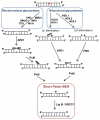Base excision repair and cancer
- PMID: 22252118
- PMCID: PMC3361536
- DOI: 10.1016/j.canlet.2011.12.038
Base excision repair and cancer
Abstract
Base excision repair is the system used from bacteria to man to remove the tens of thousands of endogenous DNA damages produced daily in each human cell. Base excision repair is required for normal mammalian development and defects have been associated with neurological disorders and cancer. In this paper we provide an overview of short patch base excision repair in humans and summarize current knowledge of defects in base excision repair in mouse models and functional studies on short patch base excision repair germ line polymorphisms and their relationship to cancer. The biallelic germ line mutations that result in MUTYH-associated colon cancer are also discussed.
Copyright © 2012 Elsevier Ireland Ltd. All rights reserved.
References
-
- Friedberg EC, Walker GC, Siede W, Wood RD, Schultz RA, Ellenberger T. DNA Repair and Mutagenesis. Second Edition ASM Press; Washington, D.C.: 2006.
-
- Mitra S, Hazra TK, Roy R, Ikeda S, Biswas T, Lock J, Boldogh I, Izumi T. Complexities of DNA base excision repair in mammalian cells. Mol Cells. 1997;7:305–312. - PubMed
-
- Krokan HE, Nilsen H, Skorpen F, Otterlei M, Slupphaug G. Base excision repair of DNA in mammalian cells. FEBS Lett. 2000;476:73–77. - PubMed
-
- Mitra S, Izumi T, Boldogh I, Bhakat KK, Hill JW, Hazra TK. Choreography of oxidative damage repair in mammalian genomes. Free Radic Biol Med. 2002;33:15–28. - PubMed
Publication types
MeSH terms
Substances
Grants and funding
LinkOut - more resources
Full Text Sources
Molecular Biology Databases
Research Materials


